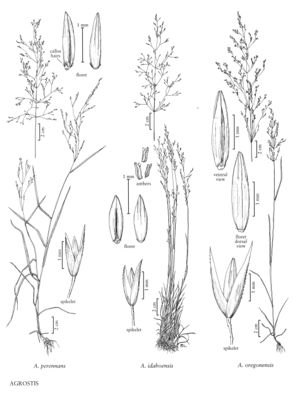Agrostis perennans
Plants perennial; cespitose, not rhizomatous or stoloniferous. Culms 20-80 cm, erect, sometimes rooting at the lower nodes, with 3-10 nodes. Leaves usually mostly cauline, basal leaves withering at anthesis; sheaths usually smooth, sometimes scabridulous, ligules (0.7)1.5-7.3 mm, dorsal surfaces scabrous, apices acute to truncate, erose to lacerate, often ciliolate; blades 6-20 cm long, 2-5 mm wide, flat, lax to stiff, cauline blades as substantial as the basal blades. Panicles 10-25 cm long, 2.5-11 cm wide, broadly ovate, open, bases usually exserted, sometimes enclosed in the upper sheaths at maturity, lowest node with (1)3-11(13) branches; branches scabridulous, capillary, wide-spreading, branching above midlength, spikelets somewhat aggregated towards the ends of the branches, lower branches 3-7 cm; pedicels 1-7.3 mm, spreading; secondary panicles sometimes present in the leaf axils. Spikelets lanceolate to narrowly ovate, green to tawny. Glumes unequal, 1.8-3.2 mm, lower glumes longer than the upper glumes. 1-veined, veins scabrous, acuminate to acute; callus hairs to 0.3 mm, abundant; lemmas 1.3-2.2 mm, smooth or scabridulous, translucent, 5-veined, veins prominent to obscure, apices acute to more or less truncate, entire or minutely denticulate, usually unawned, rarely awned from near midlength, awns to 2 mm, straight, not exserted; paleas absent, or to 0.1 mm and thin; anthers 3, 0.4-0.9 mm. Caryopses 1.1-1.9 mm; endosperm liquid. 2n = 42.
Distribution
Conn., N.J., N.Y., Del., D.C, Wis., W.Va., Mass., Maine, N.H., R.I., Vt., Fla., N.B., Nfld. And Labr. (Labr.), N.S., Ont., P.E.I., Que., Tex., La., Nebr., Tenn., N.C., S.C., Pa., Va., Kans., N.Dak., Okla., S.Dak., Calif., Ala., Oreg., Wash., Ark., Ill., Ga., Ind., Iowa, Md., Ohio, Mo., Minn., Mich., Miss., Ky.
Discussion
Agrostis perennans grows along roadsides and in fields, fens, woodlands, and periodically inundated stream banks. It is widespread and common in eastern North America; it also grows from central Mexico to central South America. There are old records from Oregon and Washington, but A. perennans does not appear to be established in western North America. It is more tolerant of shade and moisture than Agrostis scabra (p. 646), from which it differs in its later flowering, leafier culms, and its basal leaves that usually wither by anthesis.
Selected References
None.
